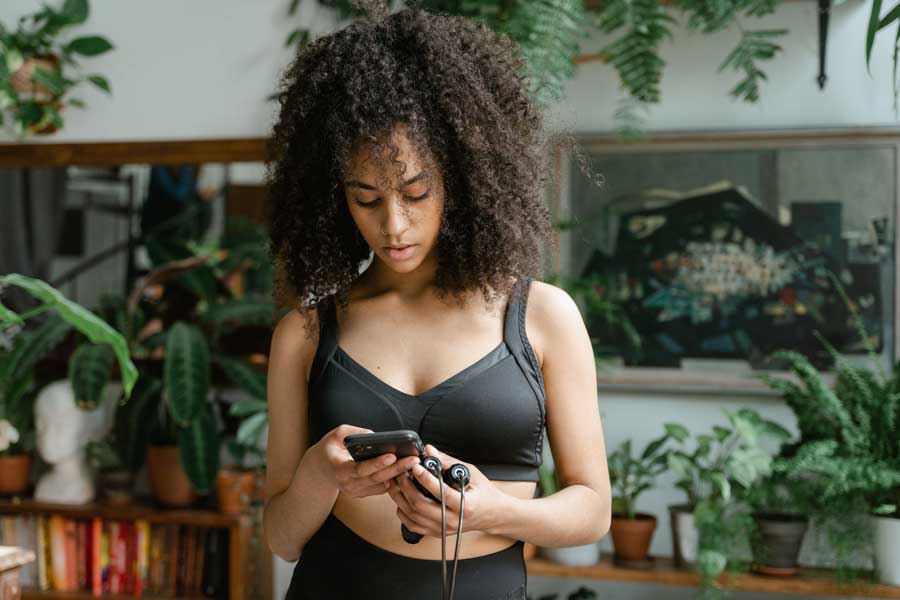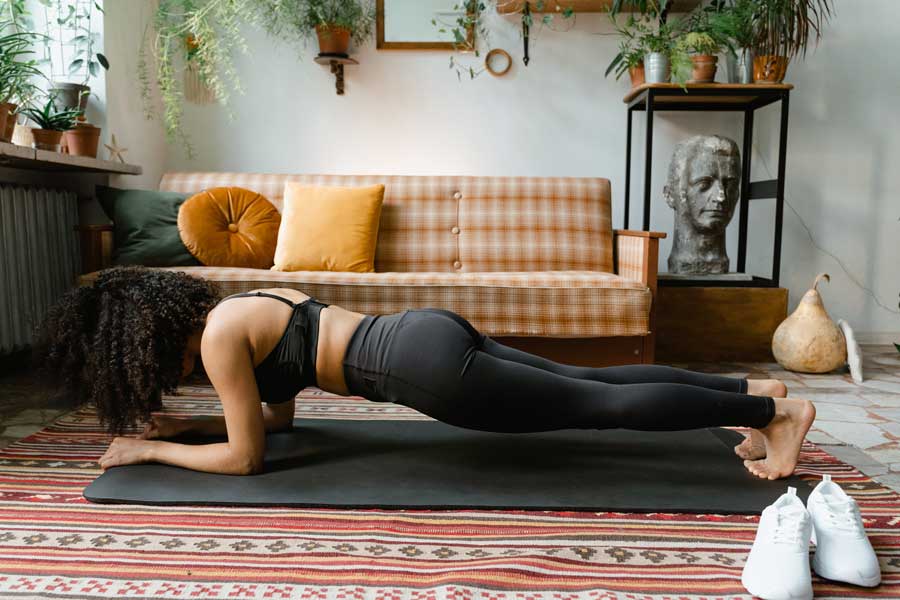
The cost of living atm is no joke – and with gym memberships around $40-60/week and personal trainers at least $100/hr, how exactly do you stay fit on a tight budget? Belts are being tightened left, right and centre while I’m trying to keep my expanding waistline in check. Literally. This foodie loves to eat. This is where AI, specifically ChatGPT, enters the chat. Technology is supposed to improve our lives, right? Yes – and no – says nutritionist, exercise scientist and personal trainer Brooke Turner.
“AI is the buzzword right now and I think, whether we like it or not, technology is here to stay,” she explains. “And while technology is useful, I see it as complementary to achieving health, fitness, and wellness goals.”
Don’t forget, she adds, AI has its benefits (like a quick and budget-friendly way to create a workout program), but it also has its limitations, too.
“AI removes the human factor. It creates programs based on the information that you provide, without it ever having ALL the essential information required to create the best program to suit everyone, such as pregnancy, mums, those with injuries, illness, or disability,” she says.
So, to put AI (and Turner’s advice) to the test, I decided to ask my new best friend ChatGPT to write me a free exercise program.
What An AI Personal Trainer Is Really Like…
Quite quickly, I realised the key to getting the most out of ChatGPT is to be detailed and precise in what you ask. For example, after way too may tries, the best prompt for me and my needs turned out to be:
“Pretend you are a personal trainer. Prepare a sample four-week, at-home exercise plan using minimal equipment for a woman in her 40s who wants to lose 20 kilograms slowly and steadily and keep the weight off. No cardio, low-impact exercises only. Specify how many reps of each exercise.”
And what came back was a pretty interesting four-week at-home exercise plan designed for me to lose some weight slowly and consistently (scroll to the bottom of the page to see my actual workout plan).
Most of the plan was basic bodyweight exercises, known to most people. Each day’s session only took 20-30 mins, so it was easy to find time and stick with it. I chose to use 3-4kg hand weights, but I liked that the plan was written to be equipment-free, suggesting that you could use household objects instead.
I liked the variety of moves, and that each day had a different body part focus. It felt very similar to professional tailored plans I’ve had in the past from personal trainers (e.g., Monday is legs day, Tuesday is upper body, rest days etc). It also made me try some exercises I wouldn’t have usually done such as Wall Sits so I enjoyed the challenge and mixing things up. Even Turner is surprised, calling it “not bad” for a basic entry-level program.
“Overall, it’s pretty balanced but it does lack variation of exercises and appropriate progressive overload as the program advances, and this would likely impact your [weight-loss] results, “ she surmises.
In addition to this, I found some of the language a bit vague (a common downside of ChatGPT) so a couple of the exercises I couldn’t visualise or wasn’t familiar with and had to Youtube those moves to see how to do them properly. Plus at times, the plan felt almost too easy and I wondered if just 30 mins a day could help me get the results I was after.
So Did It Work – Is ChatGPT My New Trainer Now?
For a free at-home training plan, ChatGPT did pretty well by covering the exercise basics and delivering a full-body workout. I feel like most people could manage to do it and you could up the ante yourself by adding more reps or heavier weights as you got stronger for more of a challenge. I already had basic exercise equipment at home, so this plan cost me exactly $0. And I didn’t need to spend any time commuting to/from a gym or trainer to do it. Sure, I could have just Googled or searched Youtube for similar generic workouts, but I felt that by inputting my specific goals, age and type of workout into ChatGPT I did actually receive a more personalised plan than I could have got by just going online. It felt more like a paid fitness app plan where you’d done a pre-screening questionnaire, minus the nutrition guidance.
After doing the plan for four weeks, I lost 2kg overall (2.5cm from my waist, 2cm from my left thigh, 1cm from my right thigh, my arms stayed the same). I also saw noticeable strength benefits. When I first started, I couldn’t even do a 30-sec Wall Sit – I found it so tough I had to break it up into 3 x 10-sec sits to hit the 30 seconds. By Week 2, I could do a 3 x 30-sec straight wall sits with minimal effort.
On week 1, I struggled to hold a 15-sec Plank, but by Week 3, I was doing 30-sec planks with what felt like no effort at all. I probably could have done a 50-sec plank by Week 4 and not even broken a sweat.
So, while I think I could probably see faster results working with a personal trainer a few times a week as they would push me harder with progressive overload and challenges – the downside is that would cost me at least $200-300 a week. And 0.5kg weight loss per week is at a sustainable and safe level so I’m pretty pleased with that. While I didn’t drop a whole dress size, my regular clothes feel much more comfortable now. If I was to do this again, I would be more specific when writing my prompt by also listing exercises that I didn’t want to include, such as lunges (my absolute most hated move).
However, Turner does have some concerns for these kinds of workouts, and some final advice.
“So much of an exercise professional’s role is to read the humans that they are working with. It’s not just an exercise program or group fitness class that we are providing, it is an experience. Something that I believe can’t be mimicked or replaced,” she says. “If you are serious about your health and exercise goals, the best thing to do is to see an expert rather than search online for answers. Connection, support, motivation, encouragement and inspiration is what experts provide. Something that AI can’t.”
My ChatGPT Workout:
“Always prioritise proper form and listen to your body. Consult with a healthcare professional before beginning any new exercise routine, especially if you have any medical conditions.
WEEKS 1-2: BUILDING STRENGTH & ENDURANCE
Day 1: Upper Body Focus
– Push-ups (knees or against a wall): 3 sets of 8 reps
– Standing dumbbell rows (use household items as weights): 3 sets of 10 reps
– Tricep dips (using a sturdy chair): 3 sets of 8 reps
– Plank: Hold for 20-30 seconds
– Bridge exercise: 3 sets of 10 reps
Day 2: Lower Body Focus
– Bodyweight squats: 3 sets of 12 reps
– Lunges (each leg): 3 sets of 10 reps
– Glute bridges: 3 sets of 10 reps
– Wall sit: Hold for 30 seconds
– Standing calf raises: 3 sets of 12 reps
Day 3: Active Recovery
– Gentle stretching and yoga for 30 minutes
Day 4: Total Body Toning
– Standing lateral raises (use household items as weights): 3 sets of 10 reps
– Bicep curls (use household items as weights): 3 sets of 10 reps
– Seated leg raises: 3 sets of 12 reps
– Plank with leg lifts: 3 sets of 8 reps (each leg)
– Clamshells (for hip strength): 3 sets of 12 reps (each side)
Day 5: Rest day
Day 6: Core Strengthening
– Modified crunches: 3 sets of 12 reps
– Russian twists (use a household item as weight): 3 sets of 10 reps (each side)
– Bird-dogs (opposite arm and leg lifts): 3 sets of 8 reps (each side)
– Plank with shoulder taps: 3 sets of 10 taps (each side)
– Seated knee tucks: 3 sets of 12 reps
Day 7: Active Recovery
– Gentle stretching and yoga for 30 minutes
WEEKS 3-4: PROGRESS & INTENSITY
During weeks 3 and 4, we’ll increase the repetitions slightly to challenge your muscles and continue building strength.
Day 1: Upper Body Focus
– Push-ups (knees or against a wall): 3 sets of 10 reps
– Standing dumbbell rows (use household items as weights): 3 sets of 12 reps
– Tricep dips (using a sturdy chair): 3 sets of 10 reps
– Plank: Hold for 30 seconds
– Bridge exercise: 3 sets of 12 reps
Day 2: Lower Body Focus
– Bodyweight squats: 3 sets of 15 reps
– Lunges (each leg): 3 sets of 12 reps
– Glute bridges: 3 sets of 12 reps
– Wall sit: Hold for 40 seconds
– Standing calf raises: 3 sets of 15 reps
Day 3: Active Recovery
– Gentle stretching and yoga for 30 minutes
Day 4: Total Body Toning
– Standing lateral raises (use household items as weights): 3 sets of 12 reps
– Bicep curls (use household items as weights): 3 sets of 12 reps
– Seated leg lifts: 3 sets of 15 reps
– Plank with leg lifts: 3 sets of 10 reps (each leg)
– Clamshells (for hip strength): 3 sets of 15 reps (each side)
Day 5: Rest day
Day 6: Core Strengthening
– Modified crunches: 3 sets of 15 reps
– Russian twists (use a household item as weight): 3 sets of 12 reps (each side)
– Bird-dogs (opposite arm and leg lifts): 3 sets of 10 reps (each side)
– Plank with shoulder taps: 3 sets of 12 taps (each side)
– Seated knee tucks: 3 sets of 15 reps
Day 7: Active Recovery
– Gentle stretching and yoga for 30 minutes
Remember to maintain a balanced diet, stay hydrated, and get enough rest. This plan provides a framework, and you can adjust the repetitions and exercises as you progress. The key is consistency and gradual progression.”



